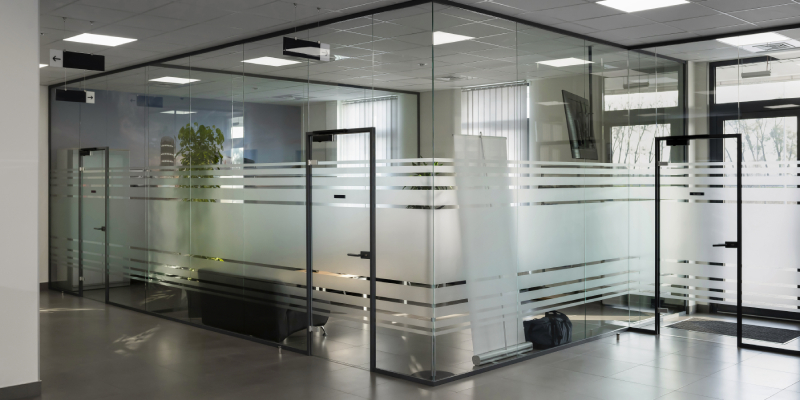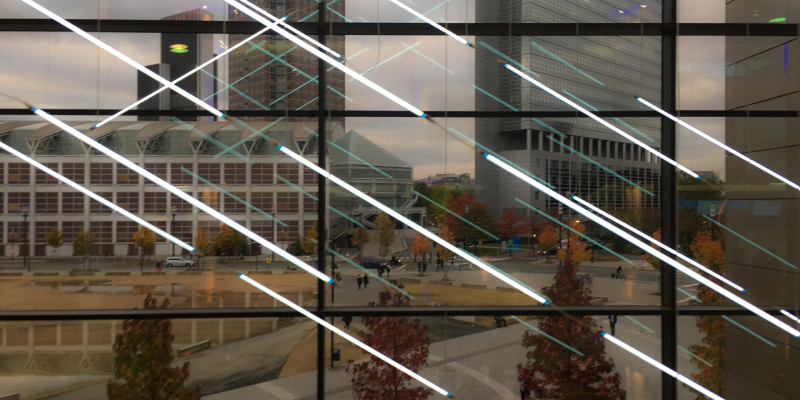Switchable glass, also known as smart glass or privacy glass, is transforming the way we design and utilize commercial spaces. In this article, we will explore the various facets of switchable glass integration for Commercial Spaces, from its benefits and types to applications.
Understanding Switchable Glass
Switchable glass operates on various technologies, such as electrochromic and liquid crystal, allowing for dynamic control of transparency. This versatility makes it suitable for a wide range of applications, providing an instant solution to privacy needs and energy efficiency.
8 Benefits of Switchable Glass for Commercial Spaces

Let’s analyze the 8 Benefits of Switchable Glass for Commercial Spaces.
Energy Efficiency
The integration of dynamic glass technology significantly enhances the energy efficiency of commercial spaces. By regulating the influx of natural light, this innovative solution reduces the reliance on artificial lighting, contributing to lower energy consumption. Moreover, the controlled transparency minimizes the need for excessive heating or cooling, leading to substantial and sustainable energy savings over time.
Privacy Control
One of the standout advantages of this transformative glass technology is its instantaneous privacy control feature. In commercial settings such as meeting rooms or executive offices, the ability to seamlessly transition from transparent to opaque ensures a secure and confidential environment. This not only enhances privacy for sensitive discussions but also adds a layer of sophistication to the overall workspace design.
Aesthetic Appeal
Beyond its functional benefits, the adaptability of this glass technology introduces a new dimension to the aesthetic appeal of commercial interiors. The ability to alter transparency provides designers with a versatile tool to create sleek, modern designs. The dynamic transformation from clear to opaque surfaces adds a sophisticated touch, contributing to an overall visually pleasing environment.
Increased Security
In addition to privacy features, the integration of dynamic glass enhances security in commercial spaces. When in opaque mode, it prevents unwanted external visibility, safeguarding sensitive information and creating a secure working environment. This additional layer of security is particularly valuable for businesses prioritizing confidentiality and protection of assets.
Versatility in Design
The flexibility offered by dynamic glass technology extends to its application in versatile design options for commercial spaces. Designers can seamlessly integrate this technology into various architectural elements, allowing for creative freedom and innovative designs. The adaptability of the glass enhances the overall aesthetic and functionality of the workspace.
Improved Employee Productivity.
The controlled entry of natural light and the ability to create private workspaces contribute to a positive impact on employee productivity. The customizable work environment created by dynamic glass fosters employee well-being and efficiency. Employees can enjoy a comfortable workspace with the option to control lighting conditions and privacy levels.
Enhanced Collaboration in Meeting Rooms
Dynamic glass facilitates collaboration in meeting rooms by seamlessly transitioning between transparency and opacity. This adaptability ensures an open and collaborative atmosphere when transparency is required, while still providing the privacy necessary for confidential discussions. The technology becomes a catalyst for effective communication and brainstorming sessions.
Compliance with Green Building Standards
The integration of dynamic glass aligns seamlessly with sustainable building practices, contributing to green certifications for commercial spaces. The energy-efficient features of this technology make it an invaluable asset for businesses aiming to meet environmental standards. The reduced energy consumption and enhanced sustainability further reinforce the commitment to eco-friendly and responsible building practices.
10 Applications of Switchable Glass for Commercial Spaces

Let’s explore the 10 Applications of Switchable Glass for Commercial Spaces.
Conference Rooms
This smart glass proves ideal for conference room settings, offering flexibility in creating an open, collaborative atmosphere when transparency is required. Simultaneously, it ensures privacy during confidential meetings, enhancing the functionality of these spaces for diverse business discussions and presentations.
Office Partitions
In open-office layouts, these types of glass partitions provide flexibility in creating private workspaces or collaborative zones. The seamless transition between transparency and opacity allows for dynamic adaptation to changing office needs, fostering a versatile and adaptive working environment.
Retail Storefronts
This smart glass enhances the appeal of retail storefronts by enabling dynamic displays. It attracts customers with interactive window presentations during business hours and ensures privacy after closing, contributing to a secure and visually engaging retail environment. This feature adds a modern and innovative touch to commercial spaces.
Hotel Lobbies
The aesthetic appeal and functionality of switchable glass make it suitable for hotel lobbies. It can be seamlessly incorporated into partitions or as decorative elements, adding a modern and sophisticated touch to the overall ambiance. The technology enhances the welcoming atmosphere of hotel reception areas.
Healthcare Facilities
This smart glass finds applications in healthcare settings, providing privacy in patient rooms or treatment areas. The ability to control visibility enhances the comfort and confidentiality of both patients and medical staff, contributing to a calming and secure healthcare environment.
Executive Offices
In executive offices where confidentiality is paramount, this intelligent glass ensures privacy when needed. It adds a touch of luxury to the office space while providing executives with the option to create an open or closed environment. The technology complements the high-end design often associated with executive offices.
Educational Institutions
This smart glass can be utilized in educational institutions for creating flexible learning environments. It allows for the adaptation of classroom layouts based on the need for transparency or privacy during lectures or collaborative activities. The technology contributes to a modern and adaptable educational infrastructure.
Restaurants and Bars
In the hospitality industry, this intelligent glass can be incorporated into restaurant and bar designs. It adds a contemporary flair and allows for the creation of private dining areas or sections with varying levels of visibility. The dynamic aspect of the glass technology contributes to the overall ambiance of dining and socializing spaces.
Museums and Galleries
This smart glass can be used in museums and galleries to control the lighting conditions for exhibits. The ability to adjust transparency contributes to the preservation of delicate artifacts and artworks, creating an optimal display environment. The technology enhances the visual experience for museum and gallery visitors.
Commercial Facades
This smart glass is an excellent choice for commercial facades, providing businesses with the option to showcase their products or services through interactive displays. It enhances the overall visual appeal of the building and attracts customer attention. The dynamic and innovative nature of the glass technology contributes to a modern and engaging commercial facade.
Conclusion
The integration of switchable glass for commercial spaces brings about a paradigm shift in design, functionality, and sustainability. From energy efficiency and improved natural lighting to enhanced privacy and aesthetic customization, the benefits are diverse and impactful. Businesses that embrace this innovative technology position themselves as pioneers in creating modern, efficient, and dynamic workspaces.
FAQs
How does switchable glass contribute to energy efficiency?
Switchable glass controls natural light, reducing the need for artificial lighting and minimizing heating or cooling requirements, resulting in energy savings.
Can switchable glass be used in open-office layouts?
Yes, switchable glass partitions offer flexibility, creating private workspaces or collaborative zones as needed in open-office setups.
What security benefits does switchable glass offer?
When opaque, switchable glass prevents external visibility, enhancing security by safeguarding sensitive information in commercial spaces.
Is switchable glass suitable for retail storefronts?
Absolutely; switchable glass enhances retail storefronts with dynamic displays during business hours and ensures privacy after closing.
How does switchable glass impact collaboration in meeting rooms?
It fosters an open and collaborative atmosphere when transparency is required while ensuring privacy for confidential discussions.





